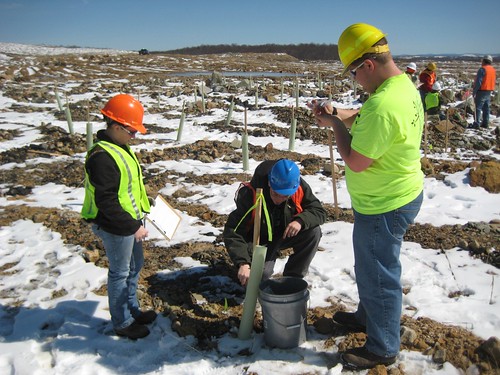
An American chestnut seedling being planted on the Wayne National Forest in Ohio. Photo credit: Jared M. Dort, US Forest Service
The land of forest-covered hills, mountain music and coal has a lesson for restoration: healthy forests require healthy soils.
The forests of Appalachia, a region that extends from southern New York to Georgia, are considered to be among the most diverse temperate deciduous forests in the world, with as many as 30 different tree species growing together. Coal has played an important role in the development of Appalachian culture, but mining for coal has also created a need for restoration in extensive areas of the 13 states that make up the Appalachian region.
Shrubby fields have replaced large swaths of forests, both as a result of mining and subsequent efforts to restore the land after mining. These shrublands have proven to be so resistant to change that some refer to their condition as “arrested” ecological succession. By one expert’s estimate, as much as a million acres—an area slightly smaller than the state of Delaware—of former deciduous, temperate forest are devoid of the trees that once thrived there.
One of the problems, according to Dr. James Burger, Professor Emeritus with Virginia Tech, is that mining turned the soils upside down. The soil in which trees grew best was buried, leaving a completely different soil type on top when the land was flattened. “The inverted soil profile can make a poor basis for reforestation,” Burger said. “Not only did trees grow poorly, but invasive species were also able to take root and capture the landscape. As a result, we’ve lost the original productivity and diversity of the native forest.”
Thanks to decades of research by soil scientists and foresters, help from volunteers and funding from state and federal governments and from private sources including coal operators, forests are beginning to return to the mined land of the Appalachians. Organizations such as the Appalachian Regional Restoration Initiative have been instrumental in developing guidelines for restoring these drastically disturbed lands. The Forestry Reclamation Approach provides five steps to successful reforestation – including how to get the soil “right”. With funding from the Appalachian Regional Commission, an organization called Green Forest Works is working to re-establish healthy and productive forests on formerly mined lands in Appalachia. More than 9,000 Green Forest Works volunteers have planted more than one million trees on nearly 2,000 acres of former mined land since 2009.
In addition, along with other organizations, Green Forest Works is reforesting 1,000 acres of reclaimed mine land with American chestnut, a native species that was found throughout Appalachia until it was devastated by a fungal disease in the early 20th Century. The American Chestnut Society, which has donated trees for use in recovering mined land, Forest Service scientists and many others have developed a strain of American chestnut tree that tolerates the disease that nearly wiped the species out a century ago.
These projects and a slew of others like them are helping restore Appalachian forests, literally from the ground up.
This post is part of a series featuring the Forest Service’s work with partners on restoration across the country. Portions of this article were adapted from an article written by Harvey Black and published in Soil Horizons, a publication of the Soil Science Society of America.

Forestry students from Glenville State College and other volunteers planting trees on reclaimed mined land in West Virginia. Photo credit: Mary Beth Adams, US Forest Service
No comments:
Post a Comment
Note: Only a member of this blog may post a comment.